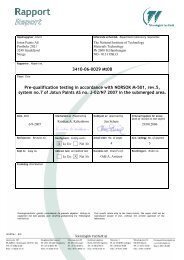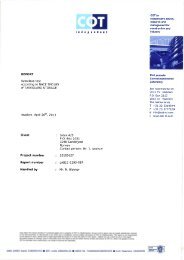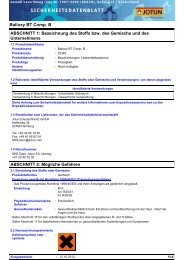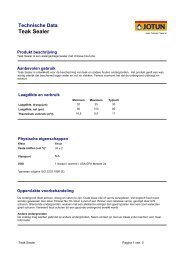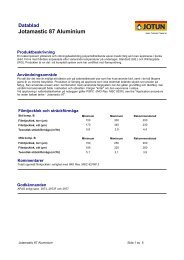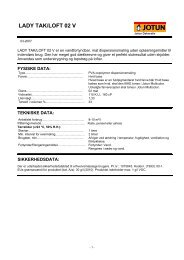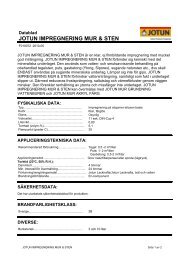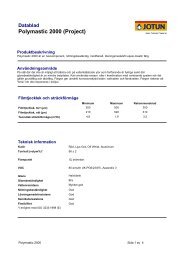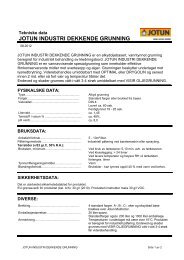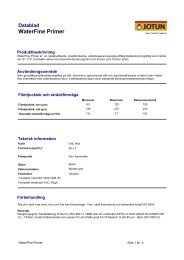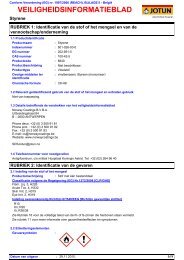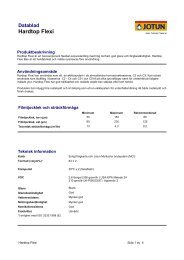Cryogenic Testing.pdf - Jotun
Cryogenic Testing.pdf - Jotun
Cryogenic Testing.pdf - Jotun
Create successful ePaper yourself
Turn your PDF publications into a flip-book with our unique Google optimized e-Paper software.
<strong>Testing</strong> Report<br />
Confidential Page 1 of 3<br />
Product Test Report <strong>Cryogenic</strong> <strong>Testing</strong> of Jotatemp 650<br />
Product Jotatemp 650<br />
Test Test procedure to demonstrate thermal shock and thermal cycling<br />
performance properties<br />
Test Method Coating testing of Jotatemp 650 for applications where temperature<br />
dip to -185ºC (-300ºF) with thermal shock to boiling water 100ºC<br />
(212ºF), This report provides summary of a short term and long<br />
term test.<br />
Reason for Test<br />
Technician<br />
Determine acceptability of Jotatemp 650 for use on cryogenic/high<br />
temperature operating equipment.<br />
This test procedure was performed under contract by the <strong>Cryogenic</strong><br />
Institute of New England, Inc.<br />
Test Panel Preparation: Test panels for <strong>Cryogenic</strong> testing consisted of 1/8” x 4” x 8” Type 304 L<br />
stainless steel. These panels were prepared by solvent cleaning with an alkaline cleaner in<br />
accordance with SSPC SP1 (solvent cleaning). Jotatemp 650 was properly mixed and then two<br />
coats of the paint were applied. Panels for the initial short term test received and average 6 mils<br />
(175 microns) Dry film thickness. The panels prepared for the second long term test received an<br />
average 5-7 mils (125 -175 microns) dry film thickness in two applications. All of the panels were<br />
allowed to ambient cure for 7 days prior to testing. Several were exposed to a hot environment of<br />
204ºC (400ºF). Heat exposed and ambient cured panels were used for sort term test. While<br />
panels for the Long term test were not heat exposed.<br />
<strong>Testing</strong> Equipment: <strong>Testing</strong> equipment consisted of the following equipment;<br />
• CDS Model #16 <strong>Cryogenic</strong> Freezer System, Closed loop Chamber with Auto-Temperature Set,<br />
Method: Liquid Nitrogen Flashing in Chamber. An external thermocouple was placed in the test<br />
chamber to verify correct temperature readings.<br />
• <strong>Cryogenic</strong> Processor Model 701 by “300 Below Icon”. An external thermocouple was placed<br />
in the test chamber to verify correct temperature readings.<br />
• Hot plate equipped with Pyrex glass with cover for boiling water bath observation<br />
Short-Term Test: Model 701 This testing consisted or placing a prepared test panel at ambient<br />
temperature, 22ºC (72ºF) into the pre-chilled chamber set at -100ºC (-148ºF). The panels were<br />
placed flat on the bottom with cardboard in between each panel in the stack. Prior to testing the<br />
samples were conditioned overnight at -100ºC (-148ºF).<br />
1
Confidential Page 2 of 3<br />
Model 16 SSB The cryogenic freezer started with an initial set point of -100℃ (-148℉) then<br />
ramped to -150℃ (-248℉). Panels were placed in the chamber vertically with the unpainted side<br />
against the thermal transfer source. <strong>Testing</strong> Procedure and Results: The test consisted of 4<br />
cycles with different samples for each unit. Each cycle included placing the chilled panel into<br />
boiling water for 5 minutes. Once the panel was placed in the boiling water, the water returned<br />
to a boil within 15-30 seconds. While transfer time was 5-10 seconds. The panels were placed<br />
back into the cryogenic freezer for 5 hours, which was then followed by a subsequent cycle.<br />
Ramp time to reach the lowest temperature was between 15 and 20 seconds. Panels were<br />
visually evaluated after each cycle and found to be acceptable. After completion of all 4 cycles,<br />
each panel was allowed to return to ambient temperature and then was subjected to both visual<br />
and adhesion inspection. Adhesion of each panel is determined by probing to determine<br />
similarity to initial cured conditions. No changes in probing characteristics resulted in a passed<br />
or acceptable condition. This test was conducted September 6, 2006.<br />
Long-Term Test: Air-cured panels were placed in a pre-cooled cryogenic chamber Model 701<br />
starting at ambient temperature (72° F/ 22° C). Two panels were prepared as described above and<br />
allowed to air dry for 5 days. One panel was scribed vertically (50% of panel). Starting on<br />
Monday the temperature in the chamber was programmed to achieve -100℉(-75℃) this<br />
temperature remained constant for 3 days (Tuesday to Thursday). Starting on Friday the program<br />
reduced the chamber temperature –149ºC (-300℉) and remained for 24 hours and started to<br />
increase the temperature to ambient within 24 hours through Sunday and by Monday morning<br />
back to ambient. This completed a one (1) week cycle. Each Thursday the panels were removed<br />
from the chamber -73ºC (-100℉) and placed into boiling water for 5-10 minutes then returned to<br />
the chamber, for a total of (4) cycles. The third and forth week of the test panels were removed<br />
from the chamber on Tuesday -73ºC (-100℉) and placed into a dry oven, set at 163ºC (325℉) for<br />
one (1) hour, then returned to the chamber at -73ºC (-100℉), for a total of two (2) cycles. Upon<br />
completion of the 4 week test, panels were analyzed using a stereomicroscope. Both<br />
panels passed this test with the same results as the short term testing. This test was<br />
completed February 2, 2007.<br />
Conclusions: Jotatemp 650 performed well considering the severity of rapid thermal<br />
shock (total range of 250°C (450° F) in 30 seconds) for both the Short & Long Term test<br />
conditions produced. The coating hardness and adhesion at -150° C (-238ºF) is good.<br />
Both heat exposed ambient cured coating systems demonstrate matched coefficient of<br />
expansion with the substrate, with acceptable recovery at cryogenic -150° C (-238ºF) and<br />
elevated temperature temperatures above 177ºC (350℉).<br />
2
Confidential Page 3 of 3<br />
3



